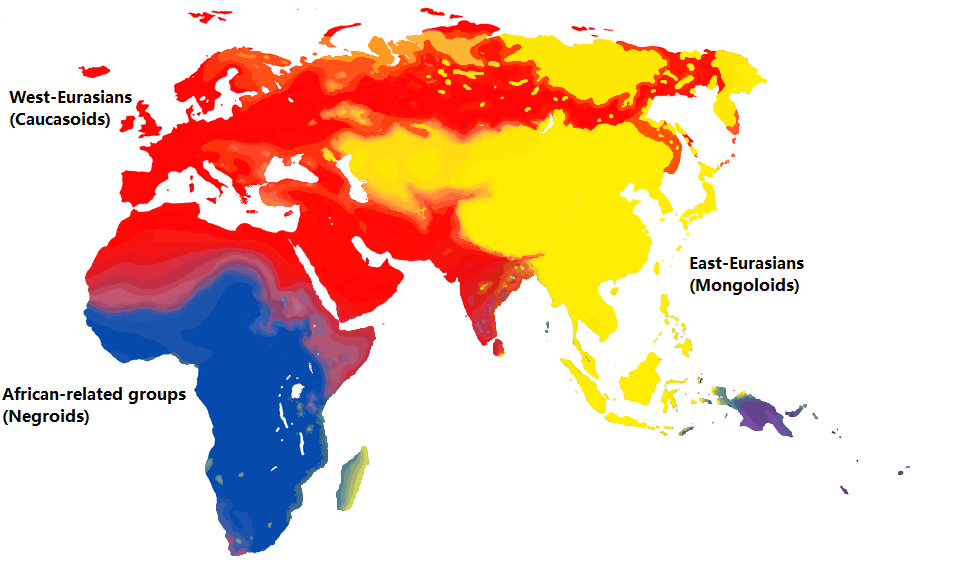Generation Six: Expansion and Exploitation: The Second Great Leap Forward
( … )
Origins: Persian Gulf and Indus River Urhiemat

The South Eurasian Urheimat
The North Eurasian Urheimat
Cultures of the Upper Paleolithic
Generation Six: Regional Adaptation
We won’t cover each of these cultures here, instead limit our discussion to those cultures that represent changes in technology in response to environmental demands.
| SW Asia (Fertile Crescent)+Emiran (50–40 ka)Ahmarian (46–42 ka)Baradostian (36–18 ka)Aurignacian (35–29 ka)Zarzian (20–10 ka)Kebaran (18–12.5 ka)Trialetian (16–8 ka)+Natufian (14.5–11.5 ka)Khiamian (12.2–10.8 ka) | EuropeBohunician (48–40 ka)+Châtelperronian (44.5–36 ka)Lincombian-Ranisian-Jerzmanowician (43–32 ka)+Aurignacian (43–26 ka)+Szeletian (41,000-37,000)Périgordian (35–20 ka)+Gravettian (33–24 ka)+Pavlovian (29–25 ka)+Solutrean (22–17 ka)+Epigravettian (20–10 ka)+Magdalenian (17–12 ka)Hamburg (15.5–13.1 ka)Federmesser (14–12.8 ka)+Azilian (14–10 ka)+Ahrensburg (13–12 ka)+Swiderian (11–8 ka) | AfricaKhormusan (42–18 ka)Iberomaurusian (25–11 ka)MushabianHalfan (22–14 ka)Qadan (15—11 ka)Sebilian (15–11 ka)Eburran (15–5 ka)Magosian (10–8 ka)SiberiaMal’ta–Buret’ (24–15 ka)Afontova Gora (21–12 ka) |
SW Asia
(Human)
Paleolithic >
Middle Paleolithic to Upper Paleolithic >
The Emiran, Bohunician, and Ahmarian Complex (??? BC to 40,000 BC) Anatomically Modern Humans spread in Eurasia. These are also the first people that appear to successfully compete with the Neanderthals.
SW Asia (Levant) >
Emiran Culture (First Anatomically Modern Eurasians) (50,000 BC to 40000 BC) existed in the Levant (Syria, Lebanon, Israel, Palestine), and Arabia between the Middle Paleolithic and the Upper Paleolithic periods. It is the oldest known of the Upper Paleolithic cultures and remains an enigma as it transitionally has no African progenitor this culture is indigenous to the Levant, and the possible Uriheimat of West Eurasians. The tools of this culture are noticably primitive compared to later work products.
SW Asia (Levant) > **Ahmarian(Elongated, Curved Blades) (**44,000 BC to 40,000 BC): The Ahmarian period together with the Emiran period, both from the Levant, are among the very first periods of the Upper Paleolithic, corresponding to the first stages of the expansion of Homo sapiens out of Africa. From this stage, the first modern humans migrated to Europe to form the beginning of the European Upper Paleolithic, including the Aurignacian culture, where they become known as the Cro-Magnons
Ahmarian blades are usually elongated with some curves. The technical knowledge of the Ahmarian culture, along with the other lithic industries, is considered the likely source of the abrupt and rapid takeover of the world in all directions as evidenced by the crossing of the Bering Strait towards America. Ahmarian technology, which included the complex of blade/bladelet-knapping techniques is also linked to the tools used by the hunter-gatherers of southwestern Asia.
SW Asia (Iran-Iraq: Zagros Mountains) >
Baradostian (34,000 BC – 16,000 BC)
(Human)
Paleolithic >
Upper Paleolithic >
Europe > Basal West Europeans (46,000 BC to 13,000 BC) – West Hunter Gatherer (WHG), European Early (Anatomically) Modern Humans (EEMH), or “Cro-Magnon” and their conquest of Europe. The founder population of all later EEMH was established by 35,000 BC, and Europe would remain in genetic isolation from the rest of the world until 12,000 BC.
The Invasion and Transition
Mousterian, Châtelperronian, Perigordian (Neanderthal) (44,500–36,000)Mousterian industry, and lasted from c. 45,000 to c. 40,000 BP, and Catelperronian Neanderthal cultures and the earliest Upper Palaeolithic industry in Central and Southwestern France, as well as in Northern Spain. Châtelperronian culture may represent a community of Neanderthals who had to some extent adopted the culture of the modern Homo sapiens that had established themselves in the surrounding area, which would account for the signs of a hybrid culture found. These hypothetical Neanderthal hold-outs would be analogous to more recent Native Americans in North and South America who adopted European technologies such as firearms or domestication of horses in order to survive in an environment dominated by more technologically advanced competitors
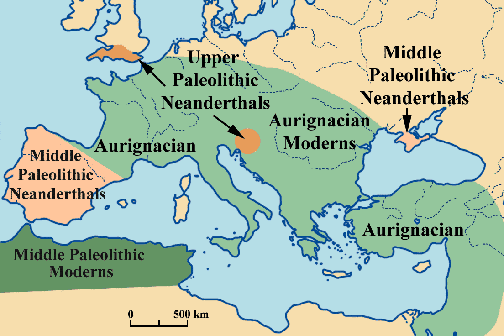
Neanderthals In Refuge (by 35,000 BC) Evidence for continued Neanderthal presence in the Iberian Peninsula.
The Completion of the Conquest of Europe
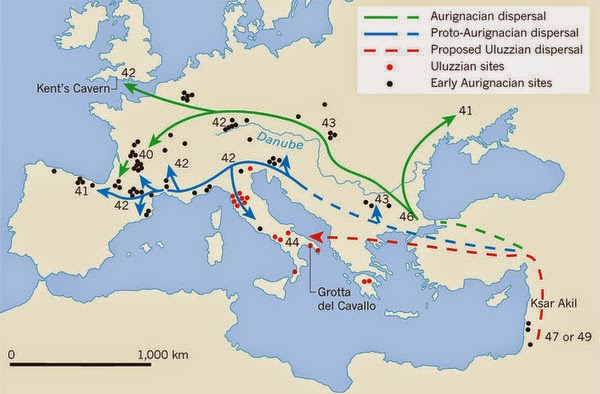
(Europe: Central and SE Europe) > Bohunician Industry (48,000 BC to 40,000 BC) (First Anotomicaly Modern Europeans) is the candidate for representing the first wave of anatomically modern humans in Europe.
Bohunician technology resembles the Mousterian, as do the contemporary assemblages of the Szeletian, Emiran and Ahmarian all these cultures apper to be related.
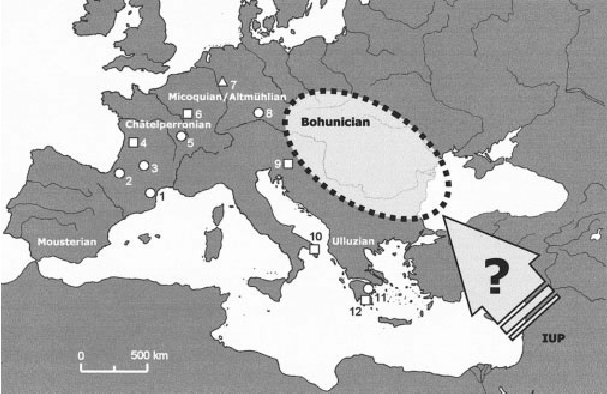
Szeletian Culture (39,000 BC to 35,000 BC) Austria, Moravia, northern Hungary, and southern Poland. It is dated years before the present (BP), most original and also the most aboriginal Upper Palaeolithic culture in Central Europe.
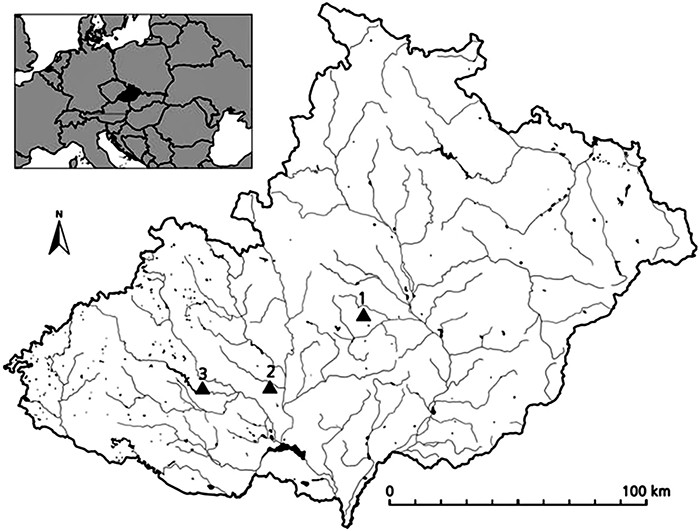
Uluzzian Culture (45,000–39,500) of Italy and Greece

The Formation of a Wholly European Culture
Europe to SW Asia
Aurignacian (41,000 BC to 24,000 BC): The Upper Paleolithic developed in Europe some time after the Levant, where the Emiran period and the Ahmarian period form the first periods of the Upper Paleolithic, corresponding to the first stages of the expansion of Homo sapiens out of Africa. They then migrated to Europe and created the first European culture of modern humans, the Aurignacian.
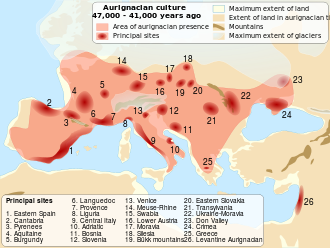
An Early Aurignacian or Proto-Aurignacian stage is dated between about 43,000 and 37,000 years ago. The Aurignacian proper lasts from about 37,000 to 33,000 years ago. A Late Aurignacian phase transitional with the Gravettian dates to about 33,000 to 26,000 years ago.
One of the oldest examples of figurative art, the Venus of Hohle Fels, comes from the Aurignacian and is dated to between 40,000 and 35,000 years ago. The German Lion-man figure is given a similar date range. The Bacho Kiro site in Bulgaria is one of the earliest known Aurignacian burials.
A “Levantine Aurignacian” culture is known from the Levant, with a type of blade technology very similar to the European Aurignacian, following chronologically the Emiran and Early Ahmarian in the same area of the Near East, and also closely related to them. The Levantine Aurignacian may have preceded European Aurignacian, but there is a possibility that the Levantine Aurignacian was rather the result of reverse influence from the European Aurignacian: this remains unsettled.
The Last Wholly European Culture
Central and Eastern Europe
Gravettian (33,000 BC to 22,000 BC) The Gravettian succeeds the Aurignacian, and is the last wholly unified European culture. West and Central Europe were extremely cold during this period. The Gravettians were hunter-gatherers who lived in this bitterly cold period of European prehistory, and Gravettian lifestyle was shaped by the climate as glacial and environmental changes forced them to adapt. They lived in caves or semi-subterranean or rounded dwellings which were typically arranged in small “villages”.

Archaeologists usually divide the culture into two regional variants: the western Gravettian, known mainly from cave sites in France, Spain and Britain, and the eastern Gravettian in Central Europe and Russia. The eastern Gravettians, which include the Pavlovian culture, were specialized mammoth hunters, whose remains are usually found not in caves but in open air sites.
The Gravettians are known for their Venus figurines, which were typically made as either ivory or limestone carvings. And they were technologically innovative, producing new arts and artifacts.
During the post glacial period, evidence of the culture begins to disappear from northern Europe but was continued in areas around the Mediterranean
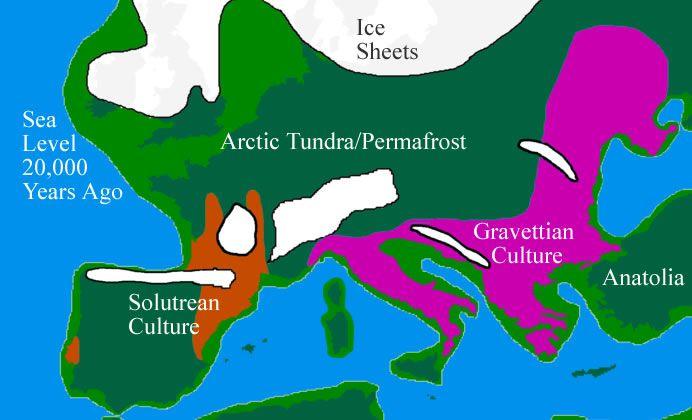
Afterward, the Soultrean abrubtly replaces it in Fance, and it continues as the Epigravettian in Italy, Balkans, Ukraine, and Russia.
Crisis: The Last Glacial Maximum
The second ice age, or Würm glaciation, of 28,000 to 10,000 years ago.
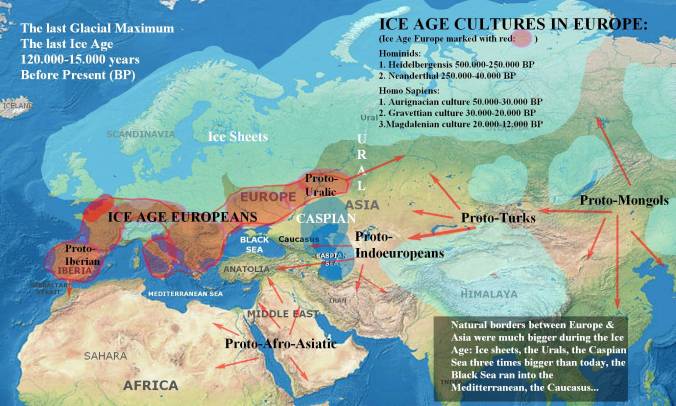
Last Glacial Maximum (LGM) (~10,000 years from ~23,000 BC to 13,000 BC)
There have been five major ice ages in earth’s history lasting from tens to a hundred million years. The last ice age started about 2.58 million years ago beginning with the spread of ice sheets in the Northern Hemisphere. Since then, the world has experienced cycles of glaciation with ice sheets advancing (glacial periods, glacials) and retreating (interglacial periods, interglacials) on 40,000- and 100,000-year time scales.
So the paleolithic revolution is interrupted the most recent glacial cycle (LGM) The peopling of the Americas occurred during this time, with East and Central Asia populations reaching the Bering land bridge after about 35 ka, and expanding into the Americas by about 15 ka. The Holocene glacial retreat begins 11.7 ka (10th millennium BC), marking the beginning of the earliest forms of farming in the Fertile Crescent.
(Human)
Paleolithic >
Upper Paleolithic > Northern Austria and Southern Poland
Pavlovian (Ice Shelf Mammot Hunters, Weaving) (27,000 BC – 23,000 BC) Pavolvians are related to the Gravettians, and they lived in the region of Moravia, northern Austria and southern Poland. They used sophisticated stone age technology to survive in the tundra on the fringe of the ice sheets around the Last Glacial Maximum. Its economy was principally based on the hunting of mammoth herds for meat, fat fuel, hides for tents and large bones and tusks for building winter shelters.
Archaeologists have excavated flint implements, polished and drilled stone artifacts, bone spearheads, needles, digging tools, flutes, bone ornaments, drilled animal teeth, and seashells. Art or religious finds include bone carvings and figurines of humans and animals made of mammoth tusk, stone, and fired clay. Textile impressions made into wet clay give the oldest proof of the existence of weaving by humans.
Basal North Eurasians
(Human)
Paleolithic >
Upper Paleolithic >The Basal North Eurasian Dispersal
Around 24,000 years ago, around the last glacial maximum, a group of people in Siberia, evolve into Ancient North Eurasians (ANE). This group was extraordinarily successful. The mutation and subsecquent evolution of blond hair evolved in the ANE population. And their evolution contributed to a cline (in order influence) of Native Americans, Europeans, Central Asians, South Asians, and some East Asians. Later dilution of Native american ANE ancestry is the result of a second migration into the Americas 5000 years ago, that all but eradicated earlier groups.
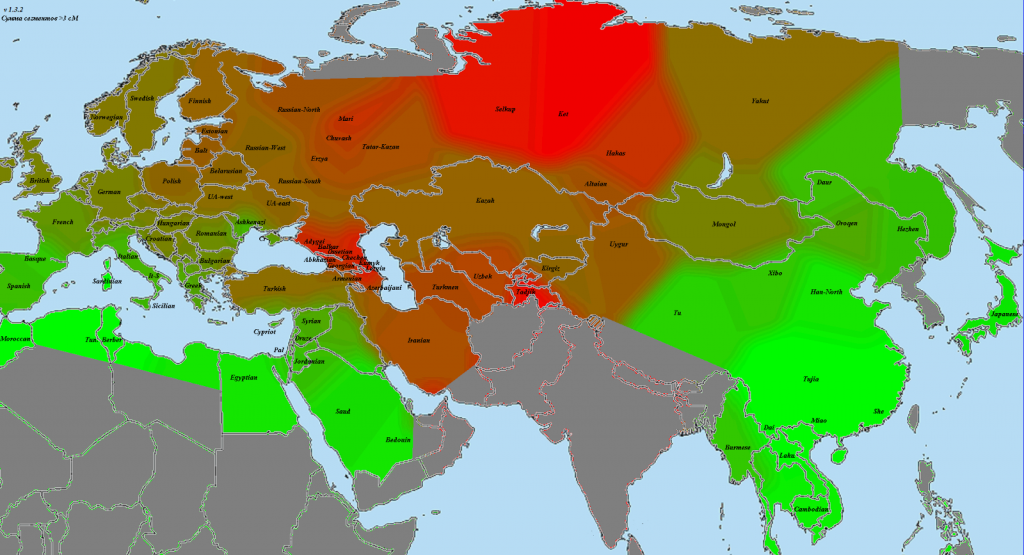 Distribution of Ancient North Eurasian Genetics
Distribution of Ancient North Eurasian Genetics
The Ice Age Migrations

The Resulting Cline West Eurasians After The ANE Expansion:
- West Siberian Hunter-Gatherer (WSG) had about 30% EHG ancestry, 50% ANE ancestry, and 20% East Asian ancestry.
- Eastern European Hunter-Gatherer (EHG) is dominated by the Ancient North Euraasian (ANE) contribution (75%).
- Scandinavian Hunter-Gatherer (SHG) were descended from Western Hunter-Gatherers who initially settled Scandinavia from the south, and later populations of EHG who entered Scandinavia from the north through the coast of Norway.
- Western Hunter-Gatherers (WHG) and EHG lineages merged in Eastern Europe, after the end of the Last Glacial Maximum, accounting for early presence of ANE ancestry in Mesolithic Europe. Evidence suggests that as Ancient North Eurasians migrated West from Eastern Siberia, they absorbed Western Hunter-Gatherers and other West Eurasian populations as well.
- Caucasian Hunter-Gatherer (CHG) dated ~26 kya, lacked ANE-admixture, by ~13 kya carried 36% ANE-derived admixture.
- Iran Neolithic (Iran_N) individuals dated ~8.5 kya carried 50% ANE-derived admixture and 50% Caucuses-related admixture,marking them as different from other Near-Eastern and Anatolian Neolithics who didn’t have ANE admixture. Iran Neolithics were later replaced by Iran Chalcolithics, who were a mixture of Iran Neolithic and Near Eastern Levant Neolithic.
This neolithic Iranian and Eastern European composition of 50% ANE will provide an interesting pattern in the milennia to come.
Basal Siberian American Dispersals:
[ ADD IMAGE OF NORTH AMERICAN DISPERSAL ]
( … )
Cultures of Post Glacial Maxium Europe
Soultrean Culture (Advanced Flint) (19,000 BC to 15,000 BC) The Soultrean period in western europe (France, spain portugal) was a transitional stage between the flint implements of the Mousterian (Neanderthal) and the bone implements of the Magdalenian epochs. The period refers to the development of highly advanced flintmaking techniques that hadn’t been seen before and weren’t rediscovered for millennia. It includes relatively finely worked, bifacial points made with lithic reduction percussion and pressure flaking rather than cruder flintknapping. Knapping was done using antler batons, hardwood batons and soft stone hammers. This method permitted the working of delicate slivers of flint to make light projectiles and even elaborate barbed and tanged arrowheads. Large thin spearheads; scrapers with edge not on the side but on the end; flint knives and saws, but all still chipped, not ground or polished; long spear-points, with tang and shoulder on one side only, are also characteristic implements of this industry. Bone and antler were used as well. They used these tools to hunt horse, reindeer, mammoth, cave lion, rhinoceros, bear and aurochs.
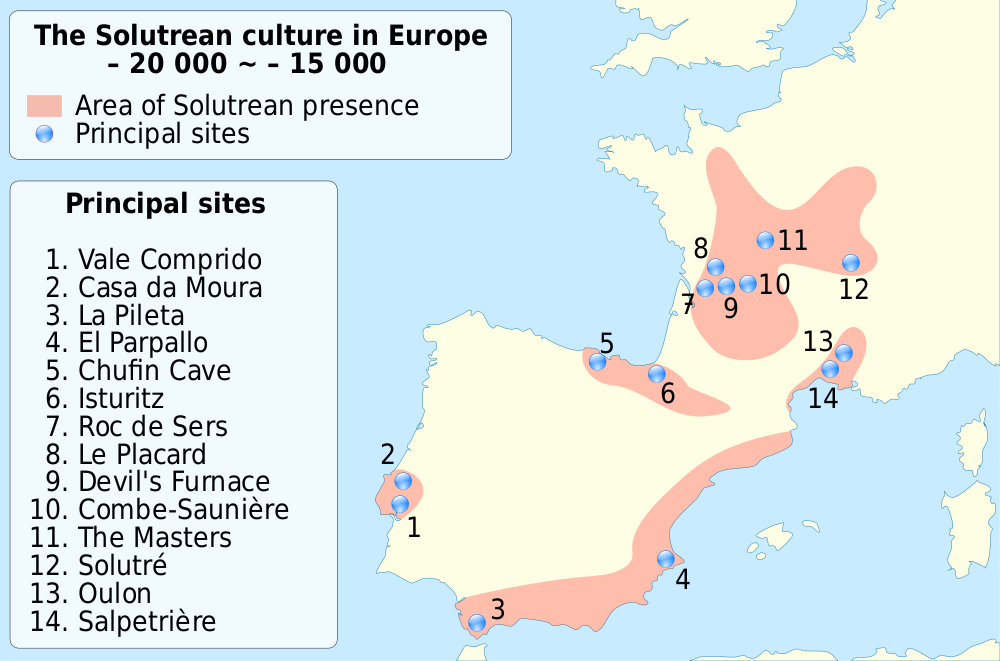
The Oldest Dryas stadial (15,000 BC)
Magdalenian Culture (Bone) (15,000 BC to 12,000 BC) cultures above the Alps were primarily reindeer hunters, although Magdalenian sites also contain extensive evidence for the hunting of red deer, horses, and other large mammals present in Europe toward the end of the last glacial period including blue foxes, Arctic hares, and other polar creatures, but included tigers and other typically tropical species. The culture was geographically widespread, stretched from Portugal in the west to Poland in the east, and as far north as France, the Channel Islands, England, and Wales. Archaology shows progress in arts and culture. It was characterized by a cold and dry climate, and the extinction of the mammoth. The use of bone and ivory as implements, begun in the preceding Solutrean epoch, increased, making the period essentially a bone period. Bone instruments are quite varied: spear-points, harpoon-heads, borers, hooks and needles. Cave sites such as Lascaux contain the best known examples of Magdalenian cave art. but most archeological remains consist of bone related artwork.
Magdalenian humans appear to have been of short stature, dolichocephalic (long skuled), with a low retreating forehead and prominent brow ridges. Human bones show cut marks and breakage, consistent with cannibalism with both flesh and bone marrow being consumed. Some skulls were cleaned of soft tissues, then had the facial regions removed, with the remaining brain case retouched, possibly to make the broken edges more regular. This manipulation suggests the shaping of skulls to produce skull cups.
The analyses suggested that 70-80% of their ancestry evolved from the Aurignacian culture of about 35,000 BP, from the Goyet Caves in modern Belgium. And that these people didn’t settle in europe but followed herds.

Epigravettian cultures below the alps the Italian Peninsula, is a similar culture appearing at the same time. Its known range extends from southeast France to the western shores of the Volga river in Russia.
Azilian culture (Decline) (14,000 BC to 12,000 BC) emerges when the climate begins to warm. The effects of melting ice sheets would have diminished the food supply and probably impoverished the previously well-fed Magdalenian manufacturers, or at least those who had not followed the herds of horse and reindeer out of the glacial refugium to new territory. As a result, Azilian tools and art were cruder and less expansive than their Ice Age predecessors – or simply different. They occupied a region similar to the Magdalenian, and in most cases the same sites. The remains are fewer and comparatively simple – indicating a smaller group of people. As the glaciers retreated, sites increasingly reach into the slopes of the Cantabrian Mountains as high as 1,000 metres above sea level, though presumably the higher ones were only occupied in the summers. the Azilian represents the tail end of the Magdalenian as the warming climate brought about changes in human behaviour in the area.
The Bølling interstadial. (13,000 BC)
Arhensburg Culture (12,900 BC to 11700 BC)

The Older Dryas stadial, Allerød interstadial. (12,000 BC)
( … )
Post Glacial Great Migrations
(Human)
Genetics >
West Eurasians >
Europeans >
European Hunter Gatherers Repopulate Europe: European hunter-gatherers (EHG) survived the Ice Age in pockets of the warmer Mediterranean climate, in today’s Spain, Italy, and either the Balkans or Greece. As the climate warmed, they followed the retreating ice north, and recolonized Europe, resulting in three groups distinct groups: Western (WHG), Scandinavia(SHG), and Eastern (EHG) european hunter-gatherers. WHGs inhabited an area stretching from the British Isles in the west to the Carpathians in the east
| The Glacial Maximum | The repopulation of europe by three primary groups as the glaciers receded. | The resulting hunter-gatherer repopulation of europe at the end of the Ice age. |
European Hunter-Gatherer (EHG), or Western Hunter Gatherer(WHG) refers to the group of descendents of hunter-gatherers of Western, Northern, Southern, and Central Europe. During the Mesolithic, the WHGs inhabited an area stretching from the British Isles in the west to the Carpathians in the east.
Eastern European Hunter-Gatherers ( EEHG, or EHG) inhabited an area stretching from the Baltic Sea to the Urals and downwards to the Pontic-Caspian steppe. The border between WHGs and EHGs ran roughly from the lower Danube, northward along the western forests of the Dnieper towards the western Baltic Sea.
Scandianvian Hunter Gathereers (SHG)s were an equal mix of Western Hunter-Gatherers (WHGs) initially populating Scandinavia from the south during the Holocene, and Eastern Hunter-Gatherers (EHGs), who later entered Scandinavia from the north along the Norwegian coast.
West Eurasians: Together these peoples, living in somewhat vertical bands across the Eurasian continent enter the ‘human era’ we call the Holocene, as the “West Eurasians“.
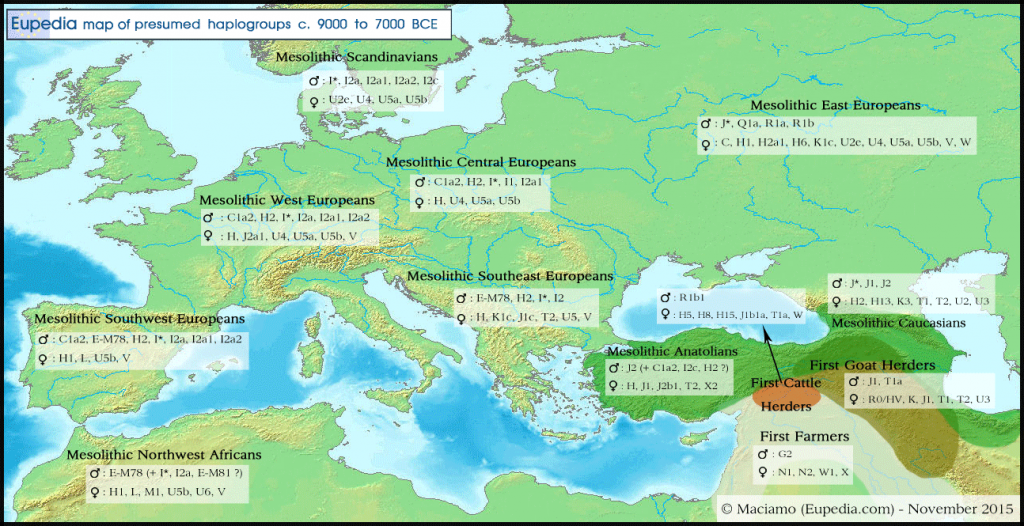 Approximate distribution of the human groups at the end of the hunter gatherer age, and just prior to the agrarian expansion.
This list should demonstrate – perphas obviously – that the reason these traits evolve by latitude (female, vitamin d, calcium): female dimorphism, and neoteny ( youth, fertility) – are the reasons for reproductive success of these traits where these traits are both reproductively beneficial and not biologically harmful.
Approximate distribution of the human groups at the end of the hunter gatherer age, and just prior to the agrarian expansion.
This list should demonstrate – perphas obviously – that the reason these traits evolve by latitude (female, vitamin d, calcium): female dimorphism, and neoteny ( youth, fertility) – are the reasons for reproductive success of these traits where these traits are both reproductively beneficial and not biologically harmful.
The Proto Populations – Subraces (Subspecies) and Languages
So far we have been discussing genetic groups of hunter gatherers. But at the end of the paleolithic we find the proto-peoples that represent the primary subraces, their languages, and their subcultures that still exist today.
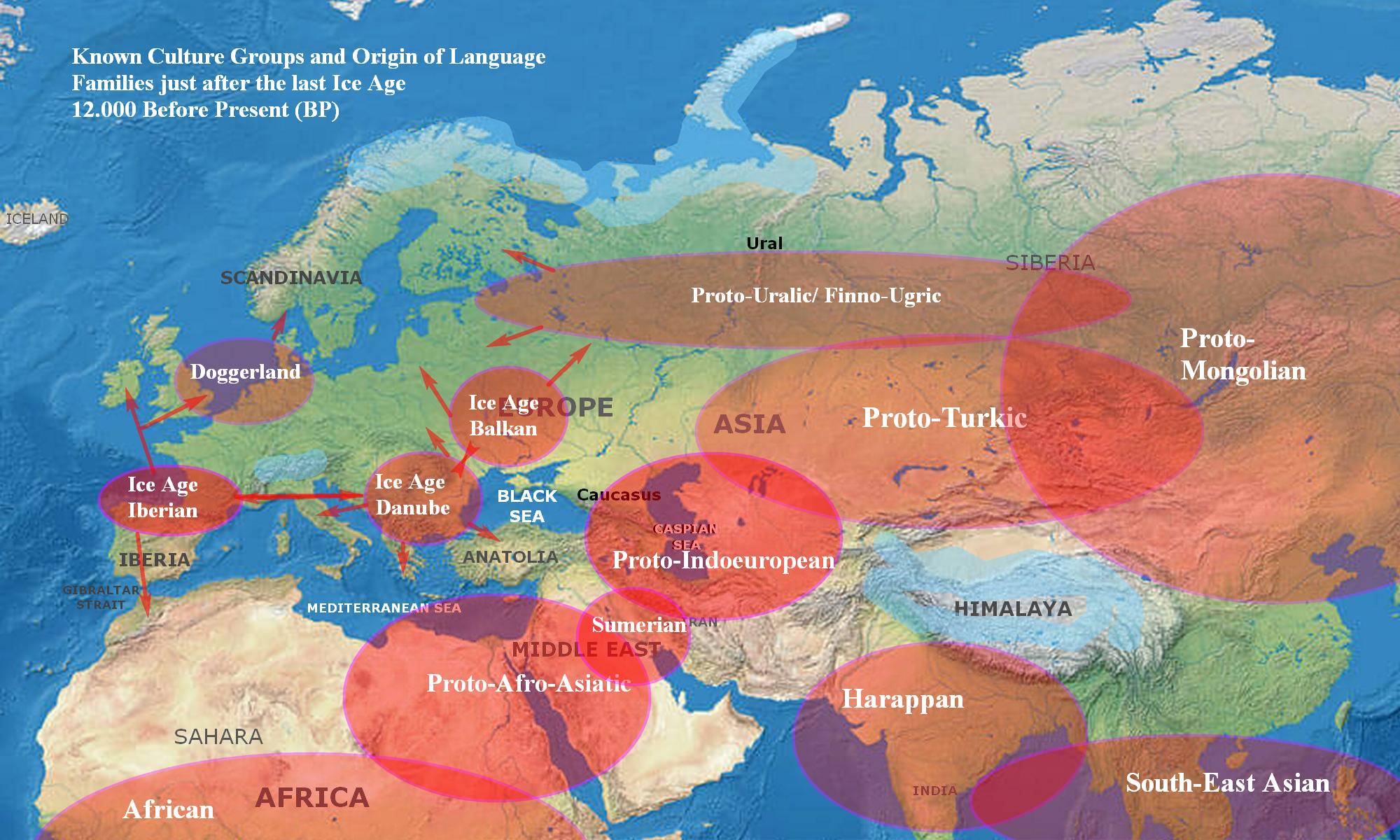
Proto-Indo European = Proto Iranic
Major Populations – The Distribution of the Races (Species)
Crisis Repeated: The Younger Dryas Period: Humans Seek Refuge
(Climate)
Quaternary > Pleistocene > Upper Pleistocene > The Younger Dryas Stadial (~1,300 years, from ~10,900 BC to around 9,700 BC) Just after the end of that ice age, the Younger Dryas Period was a major and abrupt reversal that changed the world climate from roughly 10,900BC to around 9,700 BC – lasting for ~1,300 years. The temperatures dropped substantially creating a near-glacial period. There are two competing theories of the cause, with the flooding of the north atlantic by lake Agaziz in north america, or an impact in Greenland or both.
Crises: The Anthropocene Extinction
(Ecology)
Quaternary > Pleistocene > Anthropocene
Anthropocen Extinction
Also known as the “sixth extinction”, as it is possibly the sixth mass extinction event. Mass extinctions are characterized by the loss of at least 75% of species within a geologically short period of time. There is no general agreement on where the Holocene, or anthropogenic, extinction begins, and the Quaternary extinction event, which includes climate change resulting in the end of the last ice age, ends, or if they should be considered separate events at all. The literature conflates Quaternary(climate), Holocene(Climate) with Anthropocene(Ecology), so we disambiguate the terms.
The more important question is whether the Anthropocene Extinction begins as soon as modern humans leave africa, because whether island, island-continent, subcontinent, or continent, mankind kills all megafauna as fast as they migrate – about 1km per year.

Crisis: The Persian Gulf Deluge (Flood)
( … )
